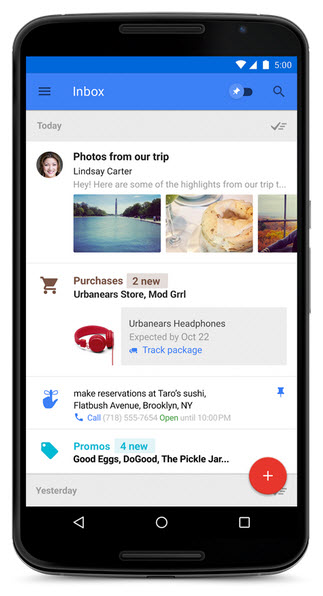
Get your FREE 30-day trial.
Please complete all fields.

Further proof of email's vitality, Google has unveiled a new email app simply called Inbox. It has some things in common with Gmail, such as auto-categorization, but does much more-some of which will make email marketers nervous.
There are two key features to pay attention to:
Bundles
This feature allows users to group emails together for viewing. That apparently also includes grouping emails-such as promotional emails-so that they only arrive once a week, for instance. Bundles seem quite similar to Unroll.me's service.
Just like Gmail Tabs, Bundles marks the further decline of the "last in on top" paradigm of the email inbox and the continued rise of the "most important on top" paradigm. And just like Tabs, Bundles likely means that marginally-engaged subscribers will become even less engaged, while engaged subscribers will become more engaged.
As users are given more and more control over their inbox experiences, the imperative for marketers to send more relevant messaging is growing clearer. Personalization, dynamic content, triggered emails, predictive intelligence, progressive profiling-all of these are the tools necessary to thrive in the next generation of inboxes.
Highlights
This is Google's new spin on snippet or preview text-envelope content that often appears under the subject line in inboxes and that traditionally has shown recipients some additional text from the body content of the email.
Highlights severely disrupts the status quo here. When appropriate, it will show images, not just text-and more importantly, it will show content that's not actually in the email in some cases. For instance, using Google's search expertise, an email about a package delivery could show you the real-time status of that delivery, even if that information isn't in the email. Given this change, we should probably start calling it snippet content, since it's no longer just text and it's not always a preview.
While a loss of control, this change might be a plus for marketers. According to yet-to-be-released research by the Salesforce Marketing Cloud involving nearly 150 B2C brands, the majority of brands aren't optimizing the snippet text of their promotional emails. That means that most of the time, subscribers are seeing snippet text composed of long, nonsensical URLs and standardized preheader copy that doesn't further their understanding of what a particular email is about. For most marketers, Highlights will likely show content that's more helpful to their subscribers.
Highlights also continues to break down the traditionally linear model of email interaction-that recipients engage with envelope content, then body content, and then landing page content before hopefully converting. Inbox gives another boost to the Stage-Bypass Model of email interaction, where subscribers can jump to landing page content right from links in the Highlights content. For marketers, this will make open rates even less of a meaningful metric over time.
Don't Panic
Currently, Inbox downloads are by invitation only, just like Gmail was initially. So there should be a very limited impact in the near-term. And even once it becomes generally available, people will have to go and download it, which will moderate both the rate of adoption and scale of adoption. This is in sharp contrast to Gmail Tabs, which was rolled out to a huge existing user base over the course of a couple of months.
Because of this, Inbox will have a gradual impact on marketers, but the trend is clear. Increasing message relevance through smart content and smart targeting is the priority for all email marketers.